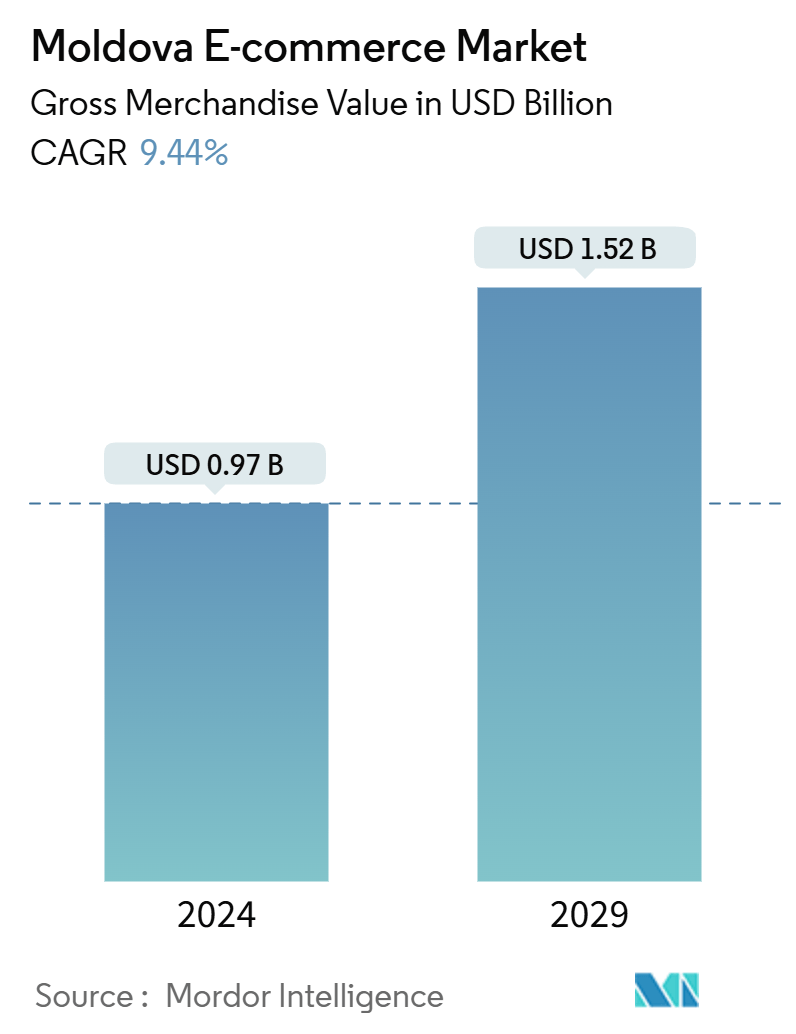Market Size of Moldova E-commerce Industry

| Study Period | 2019 - 2029 |
| Base Year For Estimation | 2023 |
| Market Size (2024) | USD 0.97 Billion |
| Market Size (2029) | USD 1.52 Billion |
| CAGR (2024 - 2029) | 9.44 % |
| Market Concentration | Low |
Major Players
*Disclaimer: Major Players sorted in no particular order |
Moldova E-commerce Market Analysis
The Moldova E-commerce Market size in terms of gross merchandise value is expected to grow from USD 0.97 billion in 2024 to USD 1.52 billion by 2029, at a CAGR of 9.44% during the forecast period (2024-2029).
In 2004, Moldova established an e-commerce law that regulated the critical components of online transactions and introduced phrases like an electronic contract. New legislation was recently passed in accordance with Moldova's EU Association Agreement/Deep and Comprehensive Free Trade Area (AA/DCFTA), with a focus on personal data protection. Moldovans mainly purchase online clothing, shoes, electronics, and travel.
- E-commerce is still in its infancy in Moldova, with only a few retailers offering it and only a few Moldovans accustomed to ordering online. In Moldova, however, the increased usage of the internet, credit cards, PayPal, and online banking is promoting e-commerce development. E-mail is becoming more widely used for corporate communication. The majority of businesses have their own websites.
- Several domestic enterprises have recently implemented online ordering and other e-commerce strategies. The popularity of online banking is growing. As the usage of smartphones increases, so does access to the internet and mobile internet, and local operators are updating their infrastructure to 4G and developing optical fiber networks.
- As internet connectivity becomes more generally available, the Moldovan e-commerce sector has grown. The COVID-19 pandemic has highlighted the importance of developing online payment and banking systems. E-mail is becoming ever more frequently used for corporate communication. The majority of businesses have their own websites. Local organizations are increasingly turning to social media for marketing objectives.
- Moreover, the Government of Moldova has developed a national digitization roadmap, which focuses on developing e-commerce, promoting online stores, attracting international e-commerce actors, and facilitating cashless payments.
Moldova E-commerce Industry Segmentation
The Moldova E-commerce market is segmented into B2C and B2B E-Commerce segments. In B2C Commerce, it is segmented By Application (Beauty & Personal Care, Consumer Electronics, Fashion & Apparel, Food & Beverage, Furniture & Home, Others (Toys, DIY, Media, etc.). Additionally, the different product types segment includes travel and tourism and sport accessories/equipment.
| By B2C E-Commerce | ||||||||
| Market Size for the Forecast Period | ||||||||
|
| By B2B E-Commerce | |
| Market Size for the Forecast Period |
Moldova E-commerce Market Size Summary
The Moldovan e-commerce market is in a nascent stage but is poised for significant growth, driven by increasing internet penetration, the adoption of digital payment methods, and a burgeoning interest in online shopping. The government's focus on digital transformation and the establishment of e-commerce regulations have laid a foundation for this growth. The market is characterized by a growing number of domestic enterprises adopting online ordering and e-commerce strategies, alongside the expansion of internet infrastructure and mobile connectivity. The COVID-19 pandemic has further accelerated the shift towards digital channels, highlighting the necessity for robust online payment and banking systems. As a result, e-commerce is becoming an integral part of the Moldovan economy, with a particular emphasis on B2B opportunities and the potential for mobile commerce to complement traditional e-commerce.
Despite the promising growth trajectory, challenges remain, such as limited acceptance of electronic payment methods by domestic e-commerce sites and a reliance on cash on delivery. However, international platforms like AliExpress, Amazon, and eBay are popular among Moldovans, especially for electronics and fashion purchases. The government's initiatives to facilitate trade and integrate technology into the supply chain are expected to further enhance the e-commerce landscape. Additionally, the introduction of digital payment solutions like Apple Pay marks a significant step towards modernizing the payment infrastructure. With ongoing efforts to promote e-signatures and e-documents, there is substantial potential for businesses and SMEs to expand their online presence and streamline procurement processes.
Moldova E-commerce Market Size - Table of Contents
-
1. MARKET INSIGHTS
-
1.1 Market Overview
-
1.2 Industry Attractiveness-Porter's Five Forces Analysis
-
1.2.1 Bargaining Power of Suppliers
-
1.2.2 Bargaining Power of Buyers/Consumers
-
1.2.3 Threat of New Entrants
-
1.2.4 Threat of Substitute Products
-
1.2.5 Intensity of Competitive Rivalry
-
-
1.3 Key market trends and share of E-Commerce of Total Retail sector
-
1.4 Impact of COVID-19 on the E-Commerce sales
-
-
2. MARKET SEGMENTATION
-
2.1 By B2C E-Commerce
-
2.1.1 Market Size for the Forecast Period
-
2.1.2 Market Segmentation - By Application
-
2.1.2.1 Beauty & Personal Care
-
2.1.2.2 Consumer Electronics
-
2.1.2.3 Fashion & Apparel
-
2.1.2.4 Food & Beverage
-
2.1.2.5 Furniture & Home
-
2.1.2.6 Others (Toys, DIY, Media, etc.)
-
-
-
2.2 By B2B E-Commerce
-
2.2.1 Market Size for the Forecast Period
-
-
Moldova E-commerce Market Size FAQs
How big is the Moldova E-commerce Market?
The Moldova E-commerce Market size is expected to reach USD 0.97 billion in 2024 and grow at a CAGR of 9.44% to reach USD 1.52 billion by 2029.
What is the current Moldova E-commerce Market size?
In 2024, the Moldova E-commerce Market size is expected to reach USD 0.97 billion.

